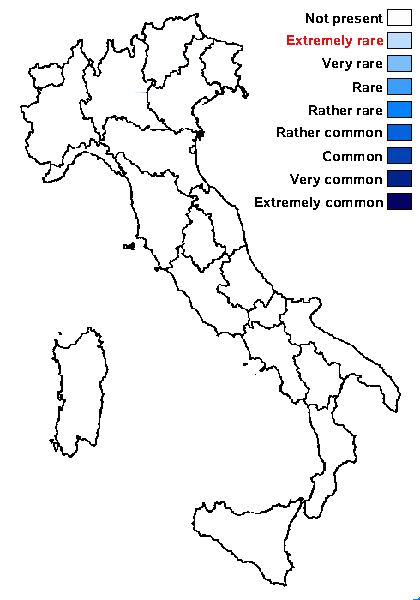Hymenelia haematina (Körb.) Lutzoni
in Lutzoni & Brodo, Syst. Bot., 20, 3: 250, 1995. Basionym: Aspicilia haematina Körb. - Parerga Lichenol., 2: 100, 1860
Synonyms: Ionaspis haematina (Körb.) Th. Fr.
Distribution:
Description: Thallus crustose, episubstratic, brown-red to rusty red, up to 0.3 mm thick, finely rimose, forming well-delimited 2-4 cm wide patches. Apothecia 0.2-0.3 mm across, with a black, urceolate disc and a thin, soon poorly evident margin. Proper exciple thin, poorly developed; epithecium blue-green, K-, N+ purple-red; hymenium partially pale blue-green, otherwise colourless; paraphyses simple or sparingly branched, submoniliform in upper part, the apical cells slightly swollen; hypothecium colourless. Asci 8-spored, cylindrical-clavate, the outer wall K/I+ blue, but the inner walls and apical dome K/I-. Ascospores 1-celled, hyaline, subglobose, 7-11 x 7-8 µm. Photobiont trentepohlioid, the cells 10-18 µm wide. Spot tests: thallus K-, C-, KC-, P-, UV-. Chemistry: without lichen substances.
Note: a silicicolous species with optimum near treeline; ecology and distribution poorly known; reported from a few localities in the Eastern Alps (Austria); to be looked for in the Italian Alps.
Growth form: Crustose
Substrata: rocks
Photobiont: Trentepohlia
Reproductive strategy: mainly sexual
Poorly known taxon in need of further study

Predictive model
Growth form: Crustose
Substrata: rocks
Photobiont: Trentepohlia
Reproductive strategy: mainly sexual
Poorly known taxon in need of further study

Predictive model
 INDEX FUNGORUM
INDEX FUNGORUM
 GBIF
GBIF

